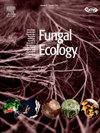Assembly of arbuscular mycorrhizal fungal communities changes from stochastic to deterministic during primary succession
IF 2.2
3区 环境科学与生态学
Q3 ECOLOGY
引用次数: 0
Abstract
On new land, succession of arbuscular mycorrhizal (AM) fungal communities depends on dispersal of propagules from a regional metacommunity and on supply of plant partners locally. We followed the succession of AM fungal communities from 2010 to 2016 on the artificial island Peberholm, which was constructed in 1998. We surveyed AM fungal communities using metabarcoding. Early in succession, AM fungal communities were characterized by a high proportion of sporulating taxa and strong dominance, consistent with a dispersal-driven mass effect imprinting the initial community composition. Over time, the prevalence of sporulating taxa declined, additional taxa were gained and β-diversity at the whole-island level increased. This pattern suggest a gradual shift towards a more deterministic assembly, where biotic interactions and environmental filtering play a greater role, leading to higher spatial differentiation of AM communities in response to abiotic conditions and plant communities.
丛枝菌根真菌群落的聚集在初级演替过程中由随机向确定性转变
在新的土地上,丛枝菌根真菌群落的演替依赖于区域元群落繁殖体的扩散和当地植物伴侣的供应。我们在1998年建造的人工岛屿Peberholm上跟踪了2010年至2016年AM真菌群落的演变。我们使用元条形码调查AM真菌群落。演替早期,AM真菌群落呈现出孢子类群比例高、优势度强的特征,与群落初始组成中由分散驱动的质量效应一致。随着时间的推移,产孢类群的流行率下降,有更多的类群出现,全岛水平的β多样性增加。这一模式表明,AM群落正逐渐向更具确定性的组合方向转变,其中生物相互作用和环境过滤发挥更大的作用,导致AM群落对非生物条件和植物群落的响应具有更高的空间分异。
本文章由计算机程序翻译,如有差异,请以英文原文为准。
求助全文
约1分钟内获得全文
求助全文
来源期刊

Fungal Ecology
环境科学-生态学
CiteScore
5.80
自引率
3.40%
发文量
51
审稿时长
3 months
期刊介绍:
Fungal Ecology publishes investigations into all aspects of fungal ecology, including the following (not exclusive): population dynamics; adaptation; evolution; role in ecosystem functioning, nutrient cycling, decomposition, carbon allocation; ecophysiology; intra- and inter-specific mycelial interactions, fungus-plant (pathogens, mycorrhizas, lichens, endophytes), fungus-invertebrate and fungus-microbe interaction; genomics and (evolutionary) genetics; conservation and biodiversity; remote sensing; bioremediation and biodegradation; quantitative and computational aspects - modelling, indicators, complexity, informatics. The usual prerequisites for publication will be originality, clarity, and significance as relevant to a better understanding of the ecology of fungi.
 求助内容:
求助内容: 应助结果提醒方式:
应助结果提醒方式:


